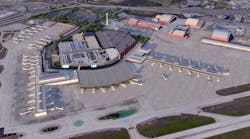… airports consider new alternatives. LaGuardia, FAA and the Port Authority of NY & NJ are looking to regulate size of aircraft flying into the facility in an attempt to move more passengers in an operations-limited environment. At LAX, the airport commission is reportedly considering buying back terminal leases from carriers in an attempt to open Los Angeles International to more competition. And, in 2006, Boston Logan opened a new runway intended to expedite aircraft flow during peak times; central to this initiative was FAA’s easing of rules on peak period pricing, a move not yet implemented but which remains a probability in the years ahead.
At LaGuardia, today’s situation is tied to two causes: 1) the physical constraints of the airfield, which do not allow for expansion; and 2) Congressional directives in 2000 that sought to end the slot rationing system used there and to push FAA to open the airport to new competition and routes. The latter move brought with it a push for smaller regional aircraft to connect various Northeast markets with LaGuardia. The Port Authority, in various reports, says that LaGuardia’s facilities (terminal, etc.) can handle as many as 10 million more passengers each year; however, the airfield infrastructure cannot. Bigger airplanes, it seems, is one answer. The airlines oppose the move. At LAX, a proposal calls for Los Angeles World Airports to spend as much as $154 million to buy back bonds originally backed by major carriers for previous terminal construction, according to reports. The move would allow the airport to regain control of exclusive-use gates in Terminals 2 and 5. In turn, LAX could then open the airport to new entrant carriers, notably Southwest.
It’s a changing airport environment. Airports Council International-North America and others have been calling for the federal government to allow them to have more business control over their facilities, to allow them to make decisions based on market forces in their regions. We may at last be at the threshold at which industry and government take a fresh look at how airports are regulated. As the new year begins, 2007 is looking more and more to be a watershed year for aviation. How the system is funded – from taxes to FAA operations to the Airport Improvement Program – is in play in Washington. How airports are regulated should also be a hot discussion item. Thanks for reading. jfi
Â



